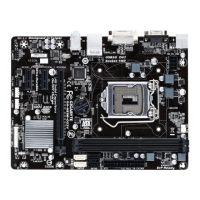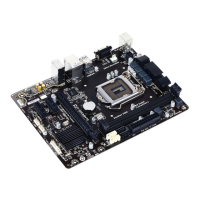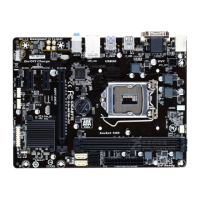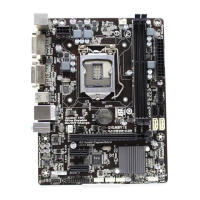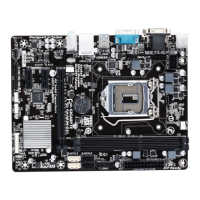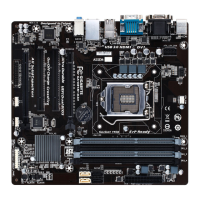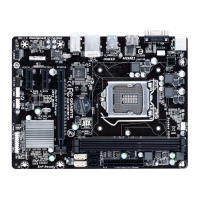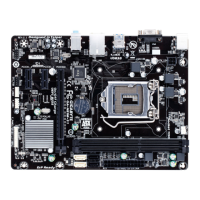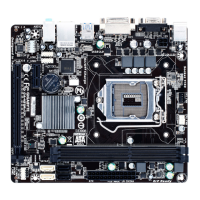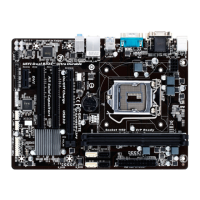Do you have a question about the Gigabyte GA-H81M-DS2 and is the answer not in the manual?
Details compliance with EU EMC and RoHS directives.
Details compliance with FCC Part 15 specifications.
Essential safety guidelines before installing hardware components.
Key technical details for CPU, memory, storage, and connectivity.
Step-by-step instructions for safely installing the processor.
Guidelines and procedures for installing RAM modules.
Procedures for adding graphics cards or other expansion devices.
Explains the function of all external ports on the rear panel.
Describes the purpose of internal motherboard headers and pinouts.
Overview of the initial GIGABYTE BIOS graphical interface.
Advanced settings for CPU, memory, and voltage tuning.
Displays current motherboard model, BIOS version, and system date/time.
Configuration options for boot order, security, and system behavior.
Settings for onboard controllers like Audio, LAN, SATA, and USB.
Options for system power states, wake-up events, and energy saving.
Procedures for saving configuration changes and exiting the BIOS.
Step-by-step guide for installing essential motherboard drivers.
Details compliance with EU EMC and RoHS directives.
Details compliance with FCC Part 15 specifications.
Essential safety guidelines before installing hardware components.
Key technical details for CPU, memory, storage, and connectivity.
Step-by-step instructions for safely installing the processor.
Guidelines and procedures for installing RAM modules.
Procedures for adding graphics cards or other expansion devices.
Explains the function of all external ports on the rear panel.
Describes the purpose of internal motherboard headers and pinouts.
Overview of the initial GIGABYTE BIOS graphical interface.
Advanced settings for CPU, memory, and voltage tuning.
Displays current motherboard model, BIOS version, and system date/time.
Configuration options for boot order, security, and system behavior.
Settings for onboard controllers like Audio, LAN, SATA, and USB.
Options for system power states, wake-up events, and energy saving.
Procedures for saving configuration changes and exiting the BIOS.
Step-by-step guide for installing essential motherboard drivers.
| Non-ECC | Yes |
|---|---|
| Memory voltage | 1.5 V |
| Memory channels | Dual-channel |
| Memory slots type | DIMM |
| Supported memory types | DDR3-SDRAM |
| Maximum internal memory | 16 GB |
| Supported memory clock speeds | 1333, 1600 MHz |
| Processor socket | LGA 1150 (Socket H3) |
| Processor manufacturer | Intel |
| Compatible processor series | Intel Celeron, Intel Pentium |
| USB 2.0 connectors | 2 |
| Number of Parallel ATA connectors | - |
| USB 3.2 Gen 1 (3.1 Gen 1) connectors | 0 |
| Peripheral (Molex) power connectors (4-pin) | 1 |
| USB 2.0 ports quantity | USB 2.0 ports have a data transmission speed of 480 Mbps, and are backwards compatible with USB 1.1 ports. You can connect all kinds of peripheral devices to them. |
| Component for | PC |
| Power source type | ATX |
| Motherboard chipset | Intel® H81 |
| PC health monitoring | CPU, FAN, Temperature |
| Audio output channels | 7.1 channels |
| Motherboard form factor | micro ATX |
| Supported storage drive interfaces | SATA II, SATA III |
| Maximum resolution | 1920 x 1200 pixels |
| Maximum graphics card memory | 1024 MB |
| PCI Express slots quantity | 3 |
| Intel® vPro™ Platform Eligibility | No |
| Bundled software | Norton Internet Security |
| Ethernet interface type | Gigabit Ethernet |
| BIOS type | EFI AMI |
| ACPI version | 2.0a |
| BIOS memory size | 128 Mbit |
| Depth | 170 mm |
|---|---|
| Width | 226 mm |
